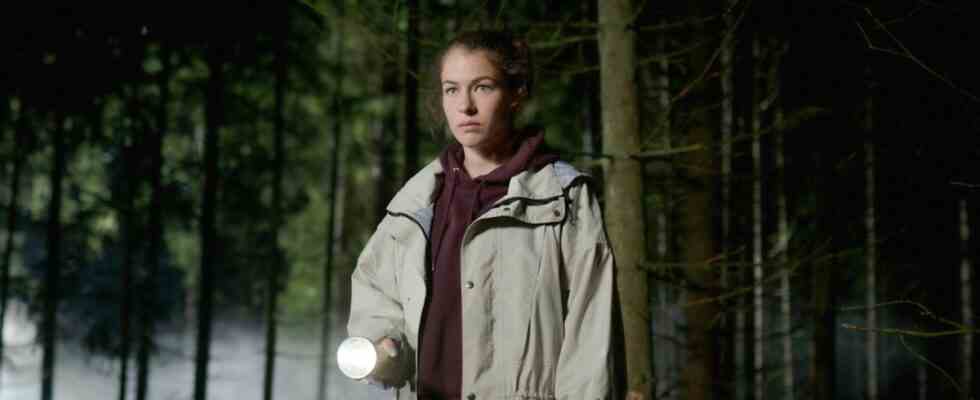There is usually a grain of truth in fairy tales. But what if the wicked witch in the crunchy house was actually the victim and her story was one of self-defense? What if Hansel and Gretel were two petty criminals who first cleared the woman’s house out of greed and then burned it down to cover their own tracks?
This is roughly how the student Anja explains the events in the Upper Palatinate town where she spent her holidays as a child. In the film “The Forest Stands Silent” she returns to the area twenty years later, only ostensibly as a forestry intern. Her father did not return from a walk here in the seventies, and the case soon ended up in the files unsolved. Now she is hoping for answers in the surrounding forest.
In fact, she comes across irregularities when surveying the land and soil: A clearing must have been dug and dug very deep years ago. What is there hidden under the ground? Anja quickly realizes that there is a bigger secret hanging over the place and the old people want to get rid of her as quickly as possible. Her surname – Anja Grimm – says it all: She moves into the godforsaken place as a narrator of new scary fairy tales in order to question the fairy tales that the population tells about their own history.
Not far from the concentration camp memorial, the small town is fighting for survival
There’s a new storyteller in the country: filmmaker Saralisa Volm has chosen an uncomfortable screenplay for her directorial debut. Wolfram Fleischhauer adapts his own thriller for this, he plays with the setting of the forest as a landscape of longing, fairytale inventory and place of natural mysticism, but also thinks about the ideological exaggeration of National Socialism in these symbolic worlds. Not far from the Flossenbürg concentration camp memorial, the small town that Anja Grimm visits is struggling to survive economically. A fairytale forest as an amusement park should fix it. Behind the taciturn Upper Palatinate dialect, a perversely pragmatic optimism is palpable.
The film lets all the buried secrets long rot under the ground and patiently builds an uneasiness to watch. Not only does Anja’s research contradict the stories of the locals, her presence alone seems to reopen old wounds in the community. A brutal murder finally throws the place into turmoil. An otherwise stoic old woman, Waltraut, freaks out: What does she want from them and how many more people would have to die before Anja finally leaves them alone? Waltraut keeps looking around in shock, feeling like he’s being watched in the forest or even being followed.
The mechanisms of collective repression are therefore the topic. “The forest stands silent” is always particularly effective when the symbol levels blur into one another. The associative imagery between microscopic nature photographs and scraps of memory from Anja’s childhood conjures up unspeakable demons that have nothing to do with Anja’s own story. In this way, she suggests connections that lie below the level of what can be told.
A modern fairy tale: from the male fantasy in hot pants to the acclaimed director
“The forest stands silent” is an impressively confident directorial debut – by Saralisa Volm, a woman who also fights fairy tales in real life. Once discovered by Klaus Lemke in Hamburg, she has detached herself from the image of the projection screen with a low décolleté and hot pants and has now arrived at the center of independent German film with her own production company Poison. In interviews and in her work, she criticizes the male-dominated structures in the film industry. With screenwriter Wolfram Fleischhauer, she already realized “Fikkefuchs” about male fantasies in 2017 and played the women’s rights activist Germaine Greer in RP Kahl’s “When Susan Sontag sat in the audience”. At the same time, however, she resists the image of the “power woman”. Journalists keep asking her how she juggles four children and this steep career and, what’s more, what a blossoming life looks like. She then says regularly that everything is actually only going so moderately well. With her Instagram project @365_imperfections she documented both personal and career setbacks. The project has been dormant for more than a year: “I just don’t have time to collect all my failures, problems, construction sites and questions,” she wrote in April 2021. Failure as self-assertion, as protest.
Speaking of self-assertion. It’s a bit of a shame that the film explicitly names the motives in the last third that lead to the eerie fog of symbols and allusions in the village. In a confession, Waltraut, the old woman, bursts out what had been in the air for a long time – that cuts the psychological horror off abruptly. Usually, when something like this happens, the director’s production has intervened. Someone who has money to lose would like to have the inexplicable explained, so that people can drink their cola in relief before the lights in the cinema go on. But in this case there is no boss, Volm produced the film himself. “On courage!” you want to shout while watching.
The effect of the somber nerve-racking of “The Forest Stands Silent” does not disappear, however, because the end prosaically reveals the secrets. It makes Saralisa Volm one of the most genuine and promising voices in German cinema.
The forest stands silent, Germany 2022 – Director: Saralisa Volm. Screenplay: Wolfram Fleischhauer. With: Henriette Confurius, Noah Saavedra, August Zirner, Robert Stadlober. Alpine republic, 90 minutes.

